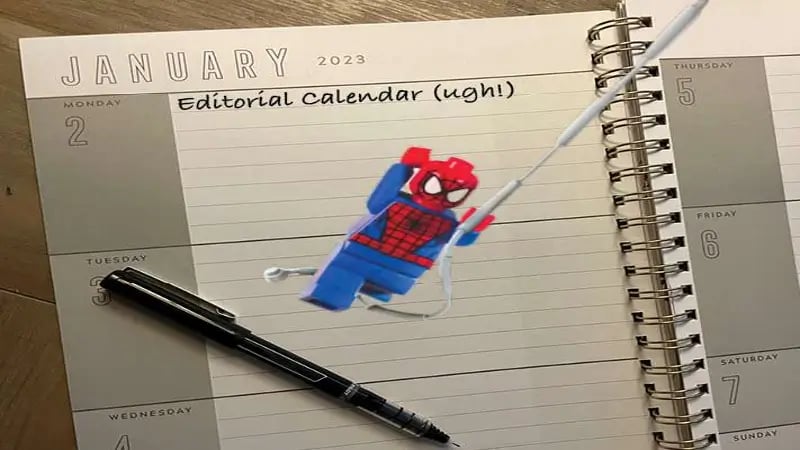7 Steps to Build an Editorial Calendar That Generates Sales Leads
Confession: I used to dread the days I had to create an editorial calendar. Creating a massive list of 50 or 60 blog article topics was daunting, even if I knew the subject matter.
I mistakenly approached the marketing editorial calendar as a trivial list of topics and due dates. I've learned that an editorial calendar can be the exciting superhero of your content marketing story!
When implemented correctly, an editorial calendar is your strategic roadmap to improved SEO and supercharged lead generation. The secret is to think of your editorial calendar regarding conversion funnels.
A conversion funnel is a content-driven path your website visitors can take to become customers eventually. A website visitor would find your blog post in a basic conversion funnel, click a CTA, and arrive on a landing page to get something awesome (like a case study or white paper). The visitor would receive that awesome thing via email and follow-up emails inviting them to learn more about your organization.
 Your content will be considered a "superhero" when it works to fuel the funnel so that at some point in the journey, the right message is received at the right time, and – BOOM – action is taken that leads to a conversion.
Your content will be considered a "superhero" when it works to fuel the funnel so that at some point in the journey, the right message is received at the right time, and – BOOM – action is taken that leads to a conversion.
These first two steps are geared toward someone starting from scratch, but they are still good to do periodically, even if you've established a more sophisticated process.
Step #1: Conduct a content audit.
A content audit aims to determine what content you already have and how it is already being used. A content audit is invaluable because most organizations have much more marketing and sales material than they realize. Check your current website, of course, and collect any materials typically used in print (e.g., trade show brochures or prospect folders). Your sales team might also have collateral that could be useful.
Start connecting the dots with the content you've found, paying attention to performance data for each piece of collateral.
Step #2: Decide which content already works well.
Once you've conducted your audit, it's time to decide what to keep and incorporate into a conversion funnel. You have two important guides for evaluating content: analytics and buyer personas.
Use analytics to evaluate online content.
Analytics is a great place to start because they tell you which content already brings people to the website and how that content performs once visitors arrive. For blog articles, consider these metrics:
-
Overall post views: The more popular a post, the more visitors it brings to your website. Look for trends in your most popular blog posts--do they all focus on a similar topic? Or perhaps they all share a format, such as a "How to.." or Industry Update.
-
Time per page view: Once visitors come to your blog post, how long do they stay? Longer times usually indicate higher engagement, translating into more visits to the related landing page. Sometimes the most successful blog articles (in terms of driving conversions) are those with fewer visitors but higher engagement.
-
Bounce rate: A high bounce rate often indicates that visitors reach a web page (in this case, a blog article) and decide it's not what they were looking for. Blog article topics that have a high bounce rate might not be a good fit for your intended audience.
Let buyer personas guide content choices.
Speaking of your intended audience, your buyer personas offer another lens for making content strategy decisions. Each buyer persona may have unique content needs. For example, CEO Chandra might be concerned about your SaaS solution's immediate and long-term ROI. But Manager Mike would probably be more interested in best practices for getting end users to adopt the solution. Both individuals play a role in purchasing decisions, so you need content for each.
As you evaluate existing content, determine which (if any) buyer persona it fits best. Weed out anything that doesn't fit a specific buyer persona. Note that some items might fit with a little strategic revision, and include those revisions as part of your editorial calendar.
Step #3: Choose an anchor for each conversion funnel.
Every conversion funnel requires something for visitors to download. It's helpful to think of this as the "anchor" for the funnel because the rest of the content in the funnel should directly relate to it. For example, one of our anchors is a social media branding checklist. All the blog articles and follow-up emails in this conversion funnel are related to social media marketing. The goal is that when someone finishes reading the blog article, the natural next step is to download the checklist.
How do you choose the right anchors? These should usually be longer-form content, such as a case study or white paper. Each anchor should address a specific business challenge – with a unique and thoughtful perspective. It should help position your company as an industry leader. And most importantly, it should inspire your website visitors to convert into leads.
No anchor? No problem.
Most content audits turn up at least a few solid options for anchor content – just about every organization has at least one white paper that can be dusted off. But if you're starting from scratch, all isn't lost. Go back to your analytics and buyer personas. What content is already working well and could be expanded into something longer? Even if you don't have the anchor complete yet, come up with an idea or two.
Website analytics is a great place to get ideas. One client observed that lots of their organic web traffic came from blog articles about cybersecurity, so our first anchor was (you guessed it!) a white paper on cybersecurity trends in healthcare. That concept can be replicated for other industries, yielding anchors for different industry-specific conversion funnels.
Step #4: Brainstorm blog article topics for each anchor.
Now that you have some meaningful starting points, the next step is true-blue brainstorming. Aim to list at least five to seven article ideas for each anchor. Remember that these ideas might not be useable, so the more you have, the better. These days, I usually aim for 10 to 15 ideas per anchor, knowing that some will be set aside.
Once you have your list, it's time to return to your analytics and buyer personas. Which of these topics best fit your buyer personas' needs? Which are similar to the topics already bringing people to your website?
Instead of forgetting those unused ideas, record them somewhere. This list can be a great place to start your next brainstorming session.
“The way to get good ideas is to get lots of ideas, and throw the bad ones away.”
- Linus Pauling, Nobel Laureate
Step #5: Use your scheduling smarts.
One mistake people often make is writing several articles about the same topic and then publishing them all back to back. As a writer, I totally get this. If I have eight articles to write about the same topic, I'd prefer to do them all at once to save time on research and write while the topic is fresh in my mind. Also, if I bundle those blog articles into a content anchor, I need them all at once anyway.
But this has a few drawbacks from a publishing perspective:
-
Your audience might tune you out. If all your blog content is about Twitter for two months, the people who want SEO advice could stop engaging with your content.
-
Your content gets stale. The Google Caffeine update gives preference to recently published content. If you post all eight articles rapidly, you won't have recent content on that topic for a long time, which can negatively impact SEO.
An alternative approach is to "de-link" your due and publication dates. For example, say you need eight articles about advertising on social media. Rather than assigning all eight articles simultaneously and publishing them as they are ready, publish them every other week for the next few months. This way, the writer can batch her related assignments, but you also have a steady flow of new articles to use over time.
When I'm scheduling an editorial calendar, I try to think in terms of my conversion funnels. If I have four conversion funnels and post two articles per week, I need an article for each funnel every other week. We also name our campaigns after our conversion funnels to keep things easy.
Step #6: Add in the "extras."
Remember that your content anchors and blog articles aren't the only things you publish. You also need a landing page and email series for each conversion funnel. Additionally, you may want to include social media ads.
Going the extra mile here will ensure all your content is aligned and driving those conversions.
Step #7: Include the information that makes writers' lives easier.
Include a link to your content brief or some of the critical elements of your brief in the calendar. They will guide your copywriters to produce content that aligns with your strategy. Make sure that the purpose of each piece of content is clear by giving specific specifications. For example:
-
Areas to discuss
-
Buyer persona of targeted readers
-
Stage of buyer's journey
-
Length of article
-
Non-text elements to include (e.g., images, videos)
-
Phrases to include
-
Potential sources
-
Potential tools
-
Quotable quotes to include
-
Topic, subtopic, and pillar page
Time to grab your calendar by the cape!
Hopefully, by now, your Spidey-sense is telling you that it would be a crime not to follow these seven key steps to sling conversions out of content. Your editorial calendar will be saving the day with sales and marketing teams. And instead of dreading the doldrums of simple scheduling, you'll now find it a task filled with swashbuckling strategy!
This content is also available in:
- German: Wie geht's? Ein redaktioneller Kalender, der Kontakte generiert.
- Spanish: 7 pasos para crear un calendario editorial que genere leads
- French: Calendrier éditorial : 7 étapes (leads)
- Italian: 7 passi per un calendario editoriale che genera lead
- Romanian: 7 pași pentru a construi un calendar editorial care generează vânzări
- Chinese: 建立可产生销售线索的编辑日历的 7 个步骤










Leave a Comment